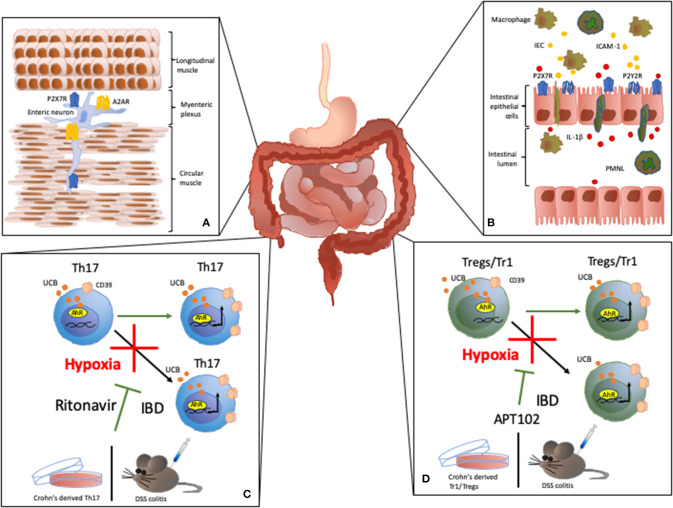Figure 2.
Effects of purinergic signaling modulation in IBD. (A) Effects on colon motility: P2X7R activity has been associated with death of enteric neurons that leads to impaired colon motility in IBD (15). A2AR activity modulates the inhibitory effect of adenosine on colonic motility during experimental colitis. (B) P2Y receptor (P2Y2R) expression and activation on intestinal epithelial cells (IEC) increases the expression of chemoattractive proteins, like ICAM-1, in IEC, promoting macrophage transepithelial migration and adhesion (16). In the inflamed lamina propria and gut epithelium, P2X7R activation triggers IL-1β secretion by IEC in response to polymorphonuclear leukocyte (PMNL) transmigration (17). (C,D) In Tr1, Treg, and Th17-cells, CD39 expression is induced upon activation of aryl hydrocarbon receptor (AhR), an intracellular receptor for pollutants, toxins and endogenous compounds, like unconjugated bilirubin (UCB). UCB boosts cell immunoregulatory properties in vitro and ameliorates the course of experimental colitis in vivo (18). However, in Crohn's disease or experimental colitis, Treg, Tr1, and Th17-cells are refractory to the regulatory effects of UCB due to a deleterious effect of hypoxia (19). Notably, we found that HIF-1α inhibition or ABC transporters blockade obtained upon administration of the antiretroviral ritonavir, limits the detrimental effects of hypoxia in Th17-cells in vitro in in vivo (19). Similarly, administration of the ADPase APT102, restores the response of Treg and Tr1-cells to the regulatory effects of UCB and ameliorates experimental colitis in vivo (20).

